sts assume role via aws cli2
In this post, we'll see how a user who has no access can have permission to AWS resource (here, S3) by assuming a role with Trust Relationship.
The makeup of an IAM role is the same as that of an IAM user and is only differentiated by the following qualities (How to use trust policies with IAM roles):
- An IAM role does not have long term credentials associated with it; rather, a principal (an IAM user, machine, or other authenticated identity) assumes the IAM role and inherits the permissions assigned to that role.
- The tokens issued when a principal assumes an IAM role are temporary. Their expiration reduces the risks associated with credentials leaking and being reused.
- An IAM role has a trust policy that defines which conditions must be met to allow other principals to assume it. This trust policy reduces the risks associated with privilege escalation.
We have a user that has no AWS resources at all:
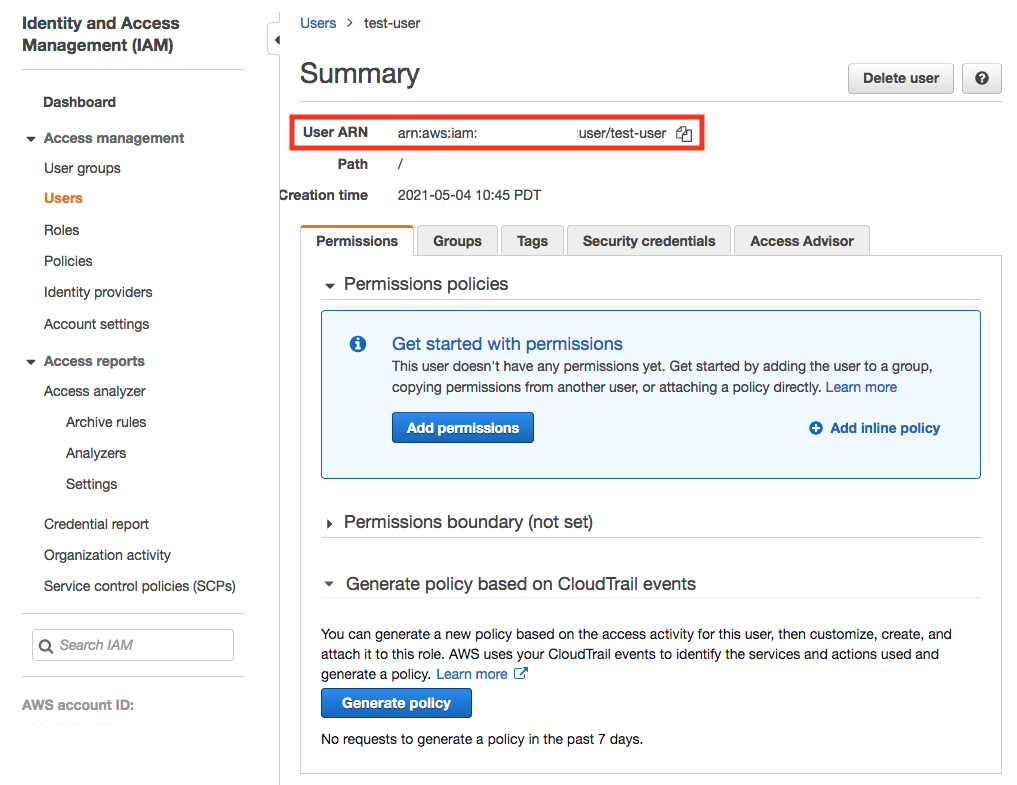
So, with current AWS credentials, the user cannot do aws s3 ls:
$ aws s3 ls An error occurred (AccessDenied) when calling the ListBuckets operation: Access Denied
However, we can let the user access to S3 resources using AssumeRole.
An admin can make a role, test-role, that has Trust Relationships with the test-user:
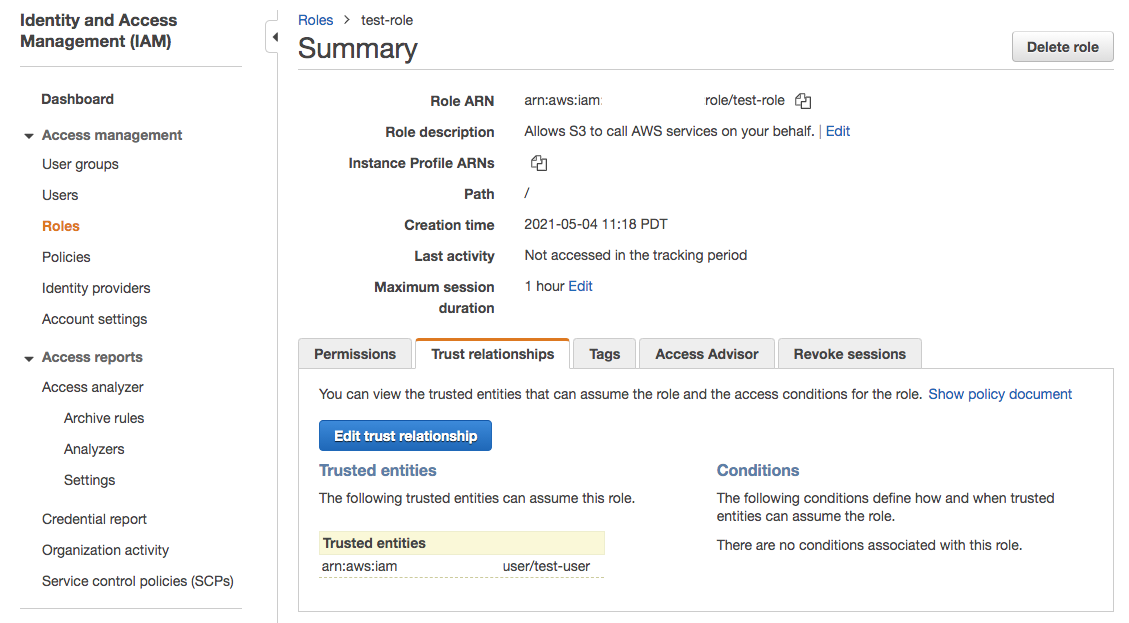
The Trust Relationship looks like this:
{
"Version": "2012-10-17",
"Statement": [
{
"Effect": "Allow",
"Principal": {
"AWS": "arn:aws:iam::xxxxxxxxxx:user/test-user"
},
"Action": "sts:AssumeRole"
}
]
}
The role has a readonly access to S3:

Now, we want to get some credentials for the test-user to assume a role of test-role that has a permission to S3.
Admin can issue the following assume-role command (check assume-role):
$ aws sts assume-role --role-arn arn:aws:iam::xxxxx:role/test-role \
--role-session-name s3-access-example --profile test-user
{
"Credentials": {
"AccessKeyId": "ASIAXVB5JUJ6DHZSQM5K",
"SecretAccessKey": "7p/V4ZIAFM2Ia1G4/Kqus86a8vOHWHRaK97k7toc",
"SessionToken": "IQoJb3JpZ2luX2VjEHsaCXVzLWVhc3QtMSJHMEUCIE4EqnrwcZXNsc6VNm70AAM8tz5xU0c5aE9P756GqK3wAiEA3BE56jjWMv7iSn0upuXYxdy/5MQfJ7OikB4zvdvTwJEqpwII9P//////////ARADGgw1MjYyNjIwNTE0NTIiDCaVPO3OjmoxTjduUCr7AT/JbepKlGIHSwDkPwt+yg1SO0xoQUBM4xHtx9HljqmUS0nwe5TJxY36me4gJE2OoVn9qjh1+aRs1AfnUOEfKQzPljhEN/PjzMU72H1+hClSY89iegjDo1gWHwUBAVoWFOMaLEyuyy3/gniA0rUOlXTgaGXavVHPYIjvlwhH1imIIZvBuC1dckAkWsrOhw6IBH5zqP8+ZIwyd5INE0sWo6lUbuaGx0TIw38Jd0qt58K4qozdptPcAyeyUwN7noOZhxrHwsVNekzIzaINnhkZhj6xO5cby4yYtP790QdYo5stGXFan2uWylTarn9P7XRhcfqCShZvGbgWD2qqMM+oxoQGOp0BK1n9SD9jgW4A//BjqkHmKt2cYNuSthDMgU7mjyirnfmxa0fxRF8fRG0lLUK069pZQJnmrfMsVZTkSyBTaJ3MD6QLJJYzz0xY8utzdATNoPAf4TYjDv2FL2ugZLUp75Nifhqbfv2Lx8CmLrQxk8yNkCyaOSGubp/UtH5YVnRl1giNl/QrqEJyMPISILycqGc2O+qaBlzkIigzvr7MNQ==",
"Expiration": "2021-05-04T19:37:03+00:00"
},
"AssumedRoleUser": {
"AssumedRoleId": "AROAXVB5JUJ6OVZSTC2H2:s3-access-example",
"Arn": "arn:aws:sts::xxxxx:assumed-role/test-role/s3-access-example"
}
}
The aws sts assume-role returns a set of temporary security credentials that we can use to access AWS resources that we might not normally have access to.
These temporary credentials consist of an access key ID, a secret access key, and a security token.
Typically, we use AssumeRole within our account (as in this section) or for cross-account access.
As we can see the output of the command that contains an access key, secret key, and session token that we can use to authenticate to AWS.
As a test-user, we can set the following:
$ export AWS_ACCESS_KEY_ID=ASIAXVB5JUJ6DHZSQM5K $ export AWS_SECRET_ACCESS_KEY=7p/V4ZIAFM2Ia1G4/Kqus86a8vOHWHRaK97k7toc $ export AWS_SESSION_TOKEN=IQoJb3JpZ2luX2VjEHs...==
Then, the test-user can list S3 buckets:
$ aws s3 ls 2020-05-06 18:37:52 bogo-test-s3-terraform-bucket 2021-04-25 12:16:29 bogo-terraform-remote-state-bucket 2021-04-28 20:44:14 bogo-terraform-serverless-examplepy ...
We (admin or test-uer) can check who (an IAM user or a role) is calling operations, in our case, the "aws s3 ls" command:
$ aws sts get-caller-identity
{
"UserId": "AROAVPSFGBEEGSNMUSQ3F:s3-access-example",
"Account": "xxxxxxxxxxxx",
"Arn": "arn:aws:sts::xxxxxxxxxxxx:assumed-role/test-role/s3-access-example"
}
We see it's the assumed role, "test-role" that's because we set env variables with temporary credentials from "sts..." output for our "test-user".
It works!
Also, note that the credentials given via aws sts assuem-role are temporary, for 1 hour as indicated in "Credentials.Expiration" section of the command output.
Now we want to assume a role via AWS console.
We have a user (dummy-user) that has no AWS resources at all including S3:

But now the user wants to assume a role that can S3 read as shown below:
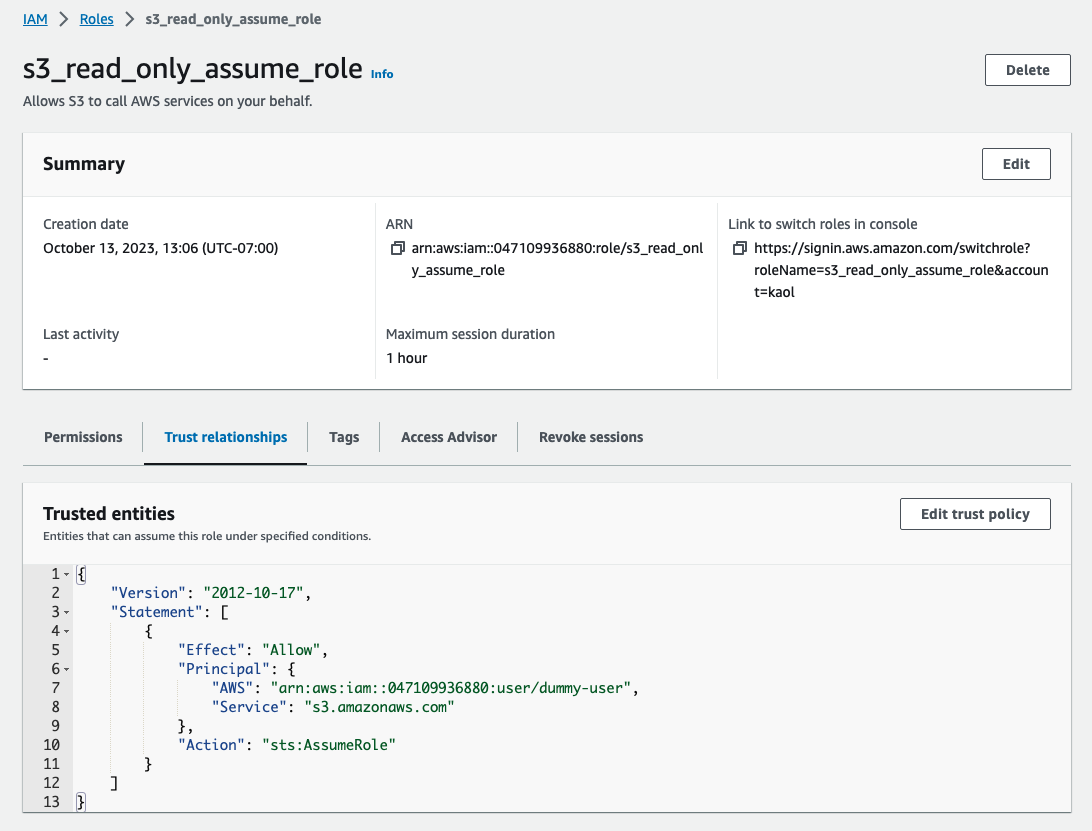
Try to switch:
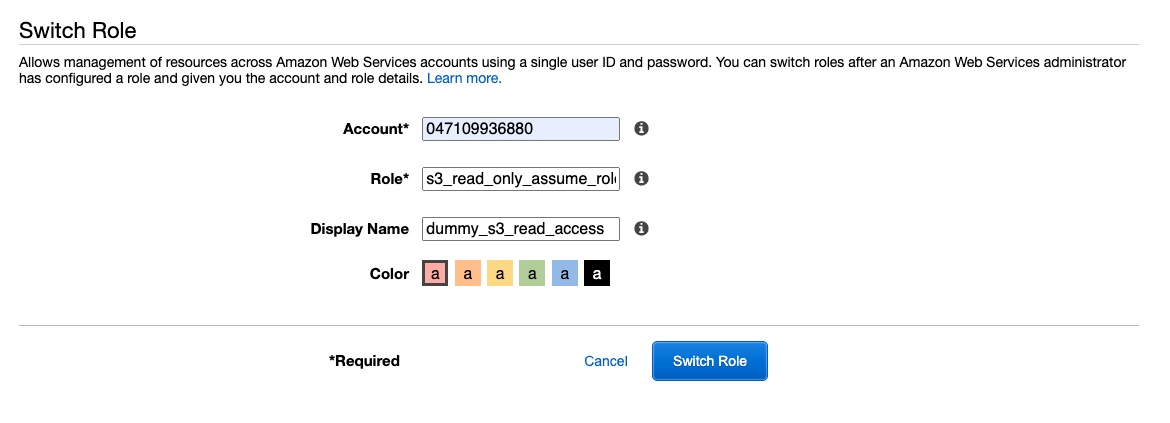
Now, the dummy-user can read S3:
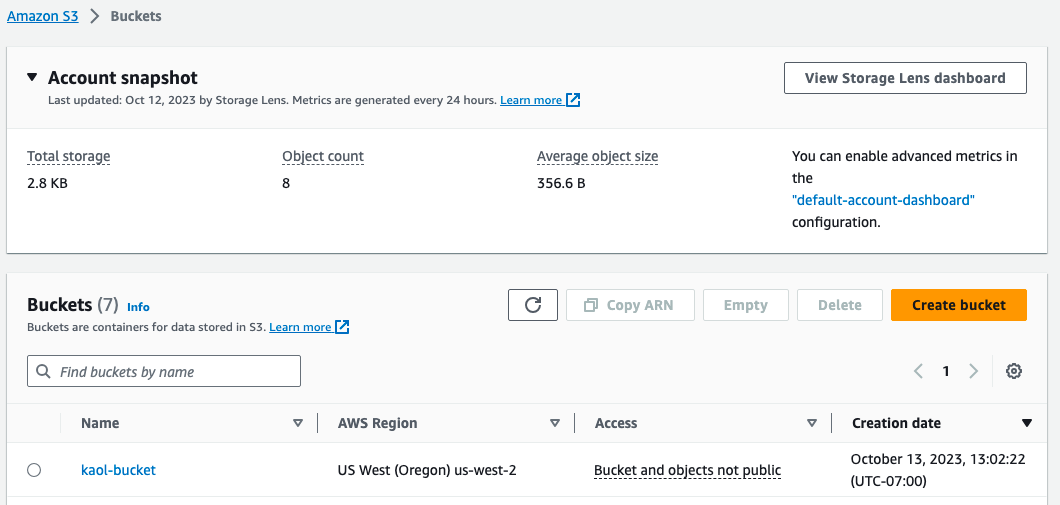
- AssumeRole
AssumeRole does require us to start with some basic AWS credentials, but those are allowed to be short-term ones as opposed to GetFederationToken. - AssumeRoleWithWebIdentity
AssumeRoleWithWebIdentity requires no AWS credentials to start with. Instead, it takes an external identity (Facebook etc.) and uses the trust policy built into the role to elevate AWS access for a short period of time. - AssumeRoleWithSAML
Same with AssumeRoleWithWebIdentity but it's used within AWS Organizations. - GetFederationToken
We must call the GetFederationToken action using the long-term security credentials of an IAM user. It scopes AWS credentials down in power (weaker) and time (shorter: up to 36h) so they can be handed out to someone else. - GetSessionToken
AWS (Amazon Web Services)
- AWS : EKS (Elastic Container Service for Kubernetes)
- AWS : Creating a snapshot (cloning an image)
- AWS : Attaching Amazon EBS volume to an instance
- AWS : Adding swap space to an attached volume via mkswap and swapon
- AWS : Creating an EC2 instance and attaching Amazon EBS volume to the instance using Python boto module with User data
- AWS : Creating an instance to a new region by copying an AMI
- AWS : S3 (Simple Storage Service) 1
- AWS : S3 (Simple Storage Service) 2 - Creating and Deleting a Bucket
- AWS : S3 (Simple Storage Service) 3 - Bucket Versioning
- AWS : S3 (Simple Storage Service) 4 - Uploading a large file
- AWS : S3 (Simple Storage Service) 5 - Uploading folders/files recursively
- AWS : S3 (Simple Storage Service) 6 - Bucket Policy for File/Folder View/Download
- AWS : S3 (Simple Storage Service) 7 - How to Copy or Move Objects from one region to another
- AWS : S3 (Simple Storage Service) 8 - Archiving S3 Data to Glacier
- AWS : Creating a CloudFront distribution with an Amazon S3 origin
- AWS : Creating VPC with CloudFormation
- AWS : WAF (Web Application Firewall) with preconfigured CloudFormation template and Web ACL for CloudFront distribution
- AWS : CloudWatch & Logs with Lambda Function / S3
- AWS : Lambda Serverless Computing with EC2, CloudWatch Alarm, SNS
- AWS : Lambda and SNS - cross account
- AWS : CLI (Command Line Interface)
- AWS : CLI (ECS with ALB & autoscaling)
- AWS : ECS with cloudformation and json task definition
- AWS Application Load Balancer (ALB) and ECS with Flask app
- AWS : Load Balancing with HAProxy (High Availability Proxy)
- AWS : VirtualBox on EC2
- AWS : NTP setup on EC2
- AWS: jq with AWS
- AWS & OpenSSL : Creating / Installing a Server SSL Certificate
- AWS : OpenVPN Access Server 2 Install
- AWS : VPC (Virtual Private Cloud) 1 - netmask, subnets, default gateway, and CIDR
- AWS : VPC (Virtual Private Cloud) 2 - VPC Wizard
- AWS : VPC (Virtual Private Cloud) 3 - VPC Wizard with NAT
- DevOps / Sys Admin Q & A (VI) - AWS VPC setup (public/private subnets with NAT)
- AWS - OpenVPN Protocols : PPTP, L2TP/IPsec, and OpenVPN
- AWS : Autoscaling group (ASG)
- AWS : Setting up Autoscaling Alarms and Notifications via CLI and Cloudformation
- AWS : Adding a SSH User Account on Linux Instance
- AWS : Windows Servers - Remote Desktop Connections using RDP
- AWS : Scheduled stopping and starting an instance - python & cron
- AWS : Detecting stopped instance and sending an alert email using Mandrill smtp
- AWS : Elastic Beanstalk with NodeJS
- AWS : Elastic Beanstalk Inplace/Rolling Blue/Green Deploy
- AWS : Identity and Access Management (IAM) Roles for Amazon EC2
- AWS : Identity and Access Management (IAM) Policies, sts AssumeRole, and delegate access across AWS accounts
- AWS : Identity and Access Management (IAM) sts assume role via aws cli2
- AWS : Creating IAM Roles and associating them with EC2 Instances in CloudFormation
- AWS Identity and Access Management (IAM) Roles, SSO(Single Sign On), SAML(Security Assertion Markup Language), IdP(identity provider), STS(Security Token Service), and ADFS(Active Directory Federation Services)
- AWS : Amazon Route 53
- AWS : Amazon Route 53 - DNS (Domain Name Server) setup
- AWS : Amazon Route 53 - subdomain setup and virtual host on Nginx
- AWS Amazon Route 53 : Private Hosted Zone
- AWS : SNS (Simple Notification Service) example with ELB and CloudWatch
- AWS : Lambda with AWS CloudTrail
- AWS : SQS (Simple Queue Service) with NodeJS and AWS SDK
- AWS : Redshift data warehouse
- AWS : CloudFormation
- AWS : CloudFormation Bootstrap UserData/Metadata
- AWS : CloudFormation - Creating an ASG with rolling update
- AWS : Cloudformation Cross-stack reference
- AWS : OpsWorks
- AWS : Network Load Balancer (NLB) with Autoscaling group (ASG)
- AWS CodeDeploy : Deploy an Application from GitHub
- AWS EC2 Container Service (ECS)
- AWS EC2 Container Service (ECS) II
- AWS Hello World Lambda Function
- AWS Lambda Function Q & A
- AWS Node.js Lambda Function & API Gateway
- AWS API Gateway endpoint invoking Lambda function
- AWS API Gateway invoking Lambda function with Terraform
- AWS API Gateway invoking Lambda function with Terraform - Lambda Container
- Amazon Kinesis Streams
- AWS: Kinesis Data Firehose with Lambda and ElasticSearch
- Amazon DynamoDB
- Amazon DynamoDB with Lambda and CloudWatch
- Loading DynamoDB stream to AWS Elasticsearch service with Lambda
- Amazon ML (Machine Learning)
- Simple Systems Manager (SSM)
- AWS : RDS Connecting to a DB Instance Running the SQL Server Database Engine
- AWS : RDS Importing and Exporting SQL Server Data
- AWS : RDS PostgreSQL & pgAdmin III
- AWS : RDS PostgreSQL 2 - Creating/Deleting a Table
- AWS : MySQL Replication : Master-slave
- AWS : MySQL backup & restore
- AWS RDS : Cross-Region Read Replicas for MySQL and Snapshots for PostgreSQL
- AWS : Restoring Postgres on EC2 instance from S3 backup
- AWS : Q & A
- AWS : Security
- AWS : Security groups vs. network ACLs
- AWS : Scaling-Up
- AWS : Networking
- AWS : Single Sign-on (SSO) with Okta
- AWS : JIT (Just-in-Time) with Okta
Ph.D. / Golden Gate Ave, San Francisco / Seoul National Univ / Carnegie Mellon / UC Berkeley / DevOps / Deep Learning / Visualization